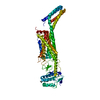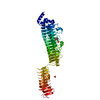[English] 日本語
 Yorodumi
Yorodumi- PDB-7tdn: CryoEM Structure of sFab COP-3 Complex with human claudin-4 and C... -
+ Open data
Open data
- Basic information
Basic information
| Entry | Database: PDB / ID: 7tdn | |||||||||
|---|---|---|---|---|---|---|---|---|---|---|
| Title | CryoEM Structure of sFab COP-3 Complex with human claudin-4 and Clostridium perfringens enterotoxin C-terminal domain | |||||||||
 Components Components |
| |||||||||
 Keywords Keywords |  MEMBRANE PROTEIN / MEMBRANE PROTEIN /  Claudin / Claudin /  cell adhesion / cell adhesion /  enterotoxin / enterotoxin /  Fab / Fab /  antibody fragment antibody fragment | |||||||||
| Function / homology |  Function and homology information Function and homology informationpositive regulation of metallopeptidase activity / calcium-independent cell-cell adhesion via plasma membrane cell-adhesion molecules / Tight junction interactions / apicolateral plasma membrane / bicellular tight junction assembly / regulation of cell morphogenesis /  tight junction / tight junction /  chloride channel activity / positive regulation of wound healing / renal absorption ...positive regulation of metallopeptidase activity / calcium-independent cell-cell adhesion via plasma membrane cell-adhesion molecules / Tight junction interactions / apicolateral plasma membrane / bicellular tight junction assembly / regulation of cell morphogenesis / chloride channel activity / positive regulation of wound healing / renal absorption ...positive regulation of metallopeptidase activity / calcium-independent cell-cell adhesion via plasma membrane cell-adhesion molecules / Tight junction interactions / apicolateral plasma membrane / bicellular tight junction assembly / regulation of cell morphogenesis /  tight junction / tight junction /  chloride channel activity / positive regulation of wound healing / renal absorption / chloride channel activity / positive regulation of wound healing / renal absorption /  chloride channel complex / lateral plasma membrane / bicellular tight junction / establishment of skin barrier / basal plasma membrane / response to progesterone / female pregnancy / chloride channel complex / lateral plasma membrane / bicellular tight junction / establishment of skin barrier / basal plasma membrane / response to progesterone / female pregnancy /  circadian rhythm / cell-cell junction / transmembrane signaling receptor activity / circadian rhythm / cell-cell junction / transmembrane signaling receptor activity /  toxin activity / toxin activity /  cell adhesion / positive regulation of cell migration / apical plasma membrane / structural molecule activity / extracellular region / identical protein binding / cell adhesion / positive regulation of cell migration / apical plasma membrane / structural molecule activity / extracellular region / identical protein binding /  plasma membrane plasma membraneSimilarity search - Function | |||||||||
| Biological species |   Homo sapiens (human) Homo sapiens (human)  Clostridium perfringens (bacteria) Clostridium perfringens (bacteria) | |||||||||
| Method |  ELECTRON MICROSCOPY / ELECTRON MICROSCOPY /  single particle reconstruction / single particle reconstruction /  cryo EM / Resolution: 5 Å cryo EM / Resolution: 5 Å | |||||||||
 Authors Authors | Vecchio, A.J. | |||||||||
| Funding support |  United States, 2items United States, 2items
| |||||||||
 Citation Citation |  Journal: J Biol Chem / Year: 2022 Journal: J Biol Chem / Year: 2022Title: Development, structure, and mechanism of synthetic antibodies that target claudin and Clostridium perfringens enterotoxin complexes. Authors: Benjamin J Orlando / Pawel K Dominik / Sourav Roy / Chinemerem P Ogbu / Satchal K Erramilli / Anthony A Kossiakoff / Alex J Vecchio /  Abstract: Strains of Clostridium perfringens produce a two-domain enterotoxin (CpE) that afflicts humans and domesticated animals, causing prevalent gastrointestinal illnesses. CpE's C-terminal domain (cCpE) ...Strains of Clostridium perfringens produce a two-domain enterotoxin (CpE) that afflicts humans and domesticated animals, causing prevalent gastrointestinal illnesses. CpE's C-terminal domain (cCpE) binds cell surface receptors, followed by a restructuring of its N-terminal domain to form a membrane-penetrating β-barrel pore, which is toxic to epithelial cells of the gut. The claudin family of membrane proteins are known receptors for CpE and also control the architecture and function of cell-cell contacts (tight junctions) that create barriers to intercellular molecular transport. CpE binding and assembly disables claudin barrier function and induces cytotoxicity via β-pore formation, disrupting gut homeostasis; however, a structural basis of this process and strategies to inhibit the claudin-CpE interactions that trigger it are both lacking. Here, we used a synthetic antigen-binding fragment (sFab) library to discover two sFabs that bind claudin-4 and cCpE complexes. We established these sFabs' mode of molecular recognition and binding properties and determined structures of each sFab bound to claudin-4-cCpE complexes using cryo-EM. The structures reveal that the sFabs bind a shared epitope, but conform distinctly, which explains their unique binding equilibria. Mutagenesis of antigen/sFab interfaces observed therein result in binding changes, validating the structures, and uncovering the sFab's targeting mechanism. From these insights, we generated a model for CpE's claudin-bound β-pore that predicted sFabs would not prevent cytotoxicity, which we then verified in vivo. Taken together, this work demonstrates the development and mechanism of claudin/cCpE-binding sFabs that provide a framework and strategy for obstructing claudin/CpE assembly to treat CpE-linked gastrointestinal diseases. | |||||||||
| History |
|
- Structure visualization
Structure visualization
| Movie |
 Movie viewer Movie viewer |
|---|---|
| Structure viewer | Molecule:  Molmil Molmil Jmol/JSmol Jmol/JSmol |
- Downloads & links
Downloads & links
- Download
Download
| PDBx/mmCIF format |  7tdn.cif.gz 7tdn.cif.gz | 141 KB | Display |  PDBx/mmCIF format PDBx/mmCIF format |
|---|---|---|---|---|
| PDB format |  pdb7tdn.ent.gz pdb7tdn.ent.gz | 107.1 KB | Display |  PDB format PDB format |
| PDBx/mmJSON format |  7tdn.json.gz 7tdn.json.gz | Tree view |  PDBx/mmJSON format PDBx/mmJSON format | |
| Others |  Other downloads Other downloads |
-Validation report
| Arichive directory |  https://data.pdbj.org/pub/pdb/validation_reports/td/7tdn https://data.pdbj.org/pub/pdb/validation_reports/td/7tdn ftp://data.pdbj.org/pub/pdb/validation_reports/td/7tdn ftp://data.pdbj.org/pub/pdb/validation_reports/td/7tdn | HTTPS FTP |
|---|
-Related structure data
| Related structure data |  25835MC  7tdmC M: map data used to model this data C: citing same article ( |
|---|---|
| Similar structure data |
- Links
Links
- Assembly
Assembly
| Deposited unit | 
|
|---|---|
| 1 |
|
- Components
Components
| #1: Protein |  CLDN4 / Clostridium perfringens enterotoxin receptor / CPE-R / CPE-receptor / Williams-Beuren syndrome ...Clostridium perfringens enterotoxin receptor / CPE-R / CPE-receptor / Williams-Beuren syndrome chromosomal region 8 protein CLDN4 / Clostridium perfringens enterotoxin receptor / CPE-R / CPE-receptor / Williams-Beuren syndrome ...Clostridium perfringens enterotoxin receptor / CPE-R / CPE-receptor / Williams-Beuren syndrome chromosomal region 8 proteinMass: 22090.201 Da / Num. of mol.: 1 Source method: isolated from a genetically manipulated source Source: (gene. exp.)   Homo sapiens (human) / Gene: CLDN4, CPER, CPETR1, WBSCR8 / Production host: Homo sapiens (human) / Gene: CLDN4, CPER, CPETR1, WBSCR8 / Production host:   Trichoplusia ni (cabbage looper) / References: UniProt: O14493 Trichoplusia ni (cabbage looper) / References: UniProt: O14493 |
|---|---|
| #2: Protein | Mass: 15114.945 Da / Num. of mol.: 1 / Fragment: C-terminal domain (UNP residues 192-319) Source method: isolated from a genetically manipulated source Source: (gene. exp.)   Clostridium perfringens (bacteria) / Gene: cpe / Production host: Clostridium perfringens (bacteria) / Gene: cpe / Production host:   Trichoplusia ni (cabbage looper) / References: UniProt: P01558 Trichoplusia ni (cabbage looper) / References: UniProt: P01558 |
| #3: Antibody | Mass: 25286.066 Da / Num. of mol.: 1 Source method: isolated from a genetically manipulated source Source: (gene. exp.)   Homo sapiens (human) / Production host: Homo sapiens (human) / Production host:   Escherichia coli (E. coli) Escherichia coli (E. coli) |
| #4: Antibody | Mass: 23729.328 Da / Num. of mol.: 1 Source method: isolated from a genetically manipulated source Source: (gene. exp.)   Homo sapiens (human) / Production host: Homo sapiens (human) / Production host:   Escherichia coli (E. coli) Escherichia coli (E. coli) |
-Experimental details
-Experiment
| Experiment | Method:  ELECTRON MICROSCOPY ELECTRON MICROSCOPY |
|---|---|
| EM experiment | Aggregation state: PARTICLE / 3D reconstruction method:  single particle reconstruction single particle reconstruction |
- Sample preparation
Sample preparation
| Component | Name: Human claudin-4/cCpE/COP-3 Complex / Type: COMPLEX Details: COP-3 sFab fragment bound to Claudin-4/cCpE complex Entity ID: all / Source: MULTIPLE SOURCES |
|---|---|
| Molecular weight | Value: 85 kDa/nm / Experimental value: NO |
| Buffer solution | pH: 7.4 |
| Specimen | Conc.: 6 mg/ml / Embedding applied: NO / Shadowing applied: NO / Staining applied : NO / Vitrification applied : NO / Vitrification applied : YES : YES |
| Specimen support | Grid mesh size: 200 divisions/in. / Grid type: Quantifoil R1.2/1.3 |
Vitrification | Instrument: FEI VITROBOT MARK IV / Cryogen name: ETHANE / Humidity: 100 % / Chamber temperature: 277 K |
- Electron microscopy imaging
Electron microscopy imaging
| Experimental equipment |  Model: Talos Arctica / Image courtesy: FEI Company |
|---|---|
| Microscopy | Model: FEI TALOS ARCTICA |
| Electron gun | Electron source : :  FIELD EMISSION GUN / Accelerating voltage: 200 kV / Illumination mode: FLOOD BEAM FIELD EMISSION GUN / Accelerating voltage: 200 kV / Illumination mode: FLOOD BEAM |
| Electron lens | Mode: BRIGHT FIELD Bright-field microscopy / Nominal magnification: 120000 X / Nominal defocus max: 2200 nm / Nominal defocus min: 1000 nm Bright-field microscopy / Nominal magnification: 120000 X / Nominal defocus max: 2200 nm / Nominal defocus min: 1000 nm |
| Image recording | Electron dose: 39.6 e/Å2 / Detector mode: COUNTING / Film or detector model: FEI FALCON III (4k x 4k) / Num. of grids imaged: 1 / Num. of real images: 3758631 |
- Processing
Processing
| Software | Name: PHENIX / Version: 1.19.2_4158: / Classification: refinement | ||||||||||||||||||||||||
|---|---|---|---|---|---|---|---|---|---|---|---|---|---|---|---|---|---|---|---|---|---|---|---|---|---|
| EM software |
| ||||||||||||||||||||||||
CTF correction | Type: PHASE FLIPPING AND AMPLITUDE CORRECTION | ||||||||||||||||||||||||
| Particle selection | Num. of particles selected: 305927 | ||||||||||||||||||||||||
| Symmetry | Point symmetry : C1 (asymmetric) : C1 (asymmetric) | ||||||||||||||||||||||||
3D reconstruction | Resolution: 5 Å / Resolution method: FSC 0.143 CUT-OFF / Num. of particles: 305927 / Num. of class averages: 1 / Symmetry type: POINT | ||||||||||||||||||||||||
| Atomic model building | B value: 413.26 / Protocol: FLEXIBLE FIT / Space: REAL | ||||||||||||||||||||||||
| Atomic model building | 3D fitting-ID: 1 / Accession code: 7TDM / Initial refinement model-ID: 1 / PDB-ID: 7TDM / Source name: PDB / Type: experimental model
| ||||||||||||||||||||||||
| Refine LS restraints |
|
 Movie
Movie Controller
Controller














 PDBj
PDBj


